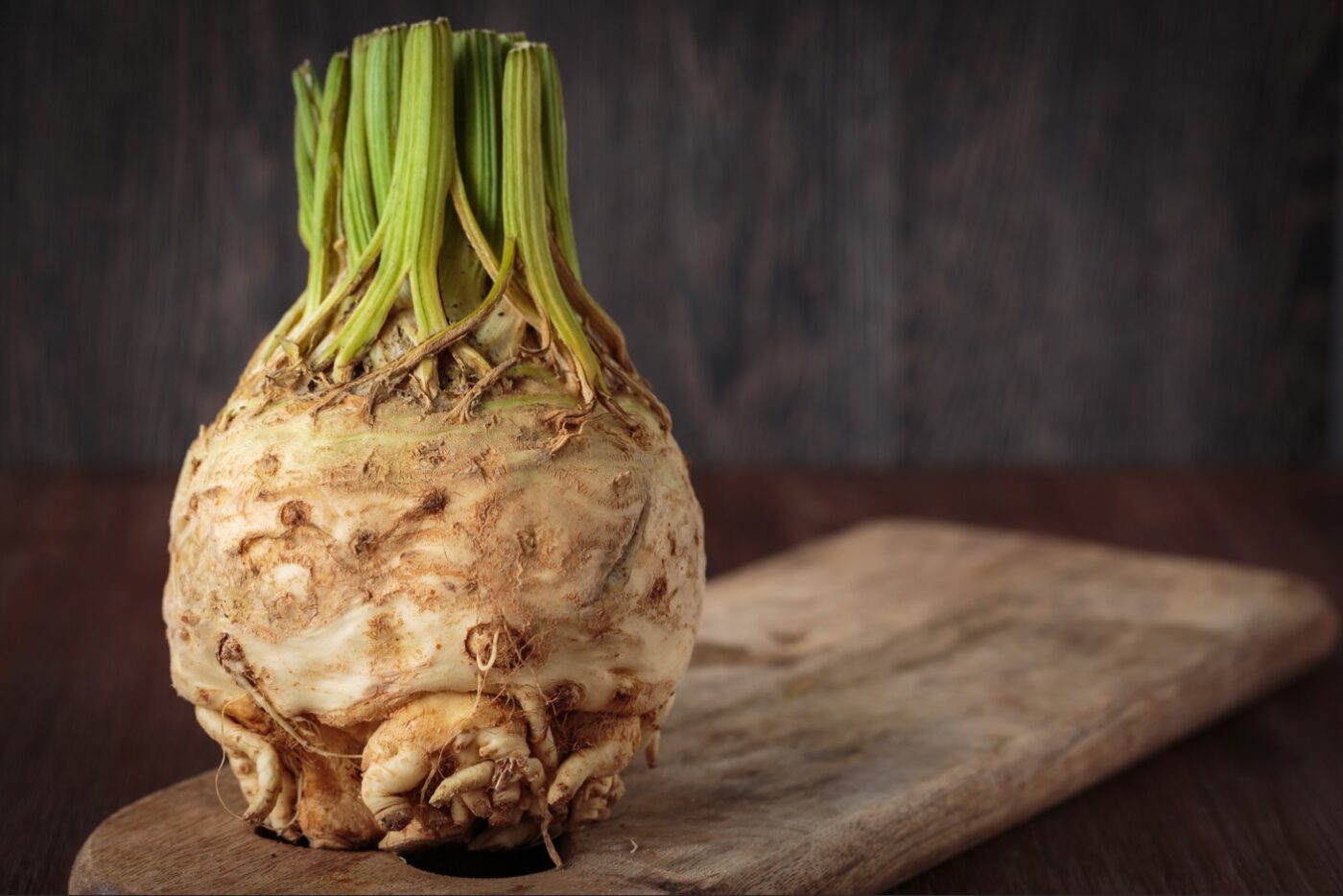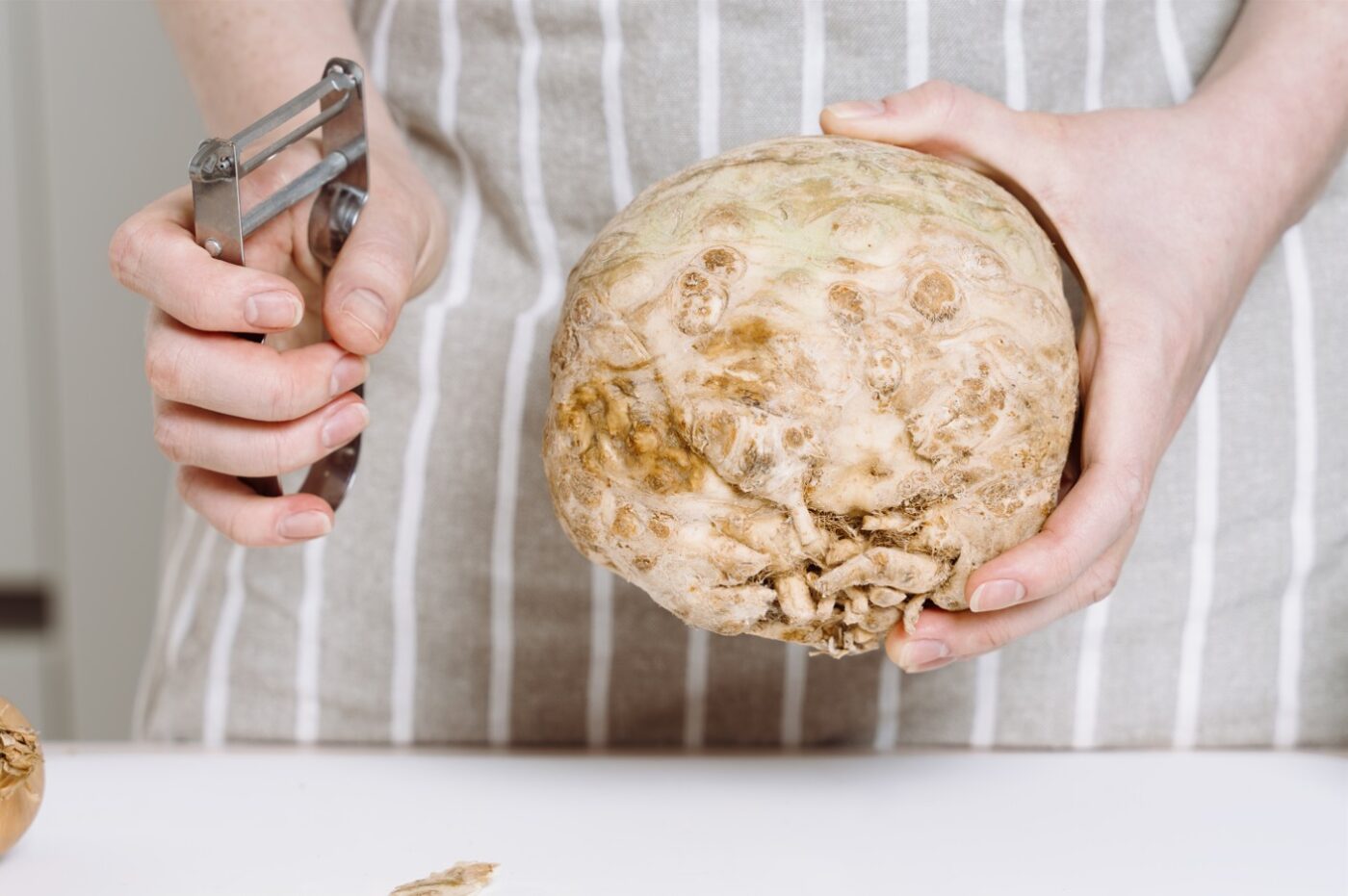Read More: Nutritional Information on Celery Root Celeriac
Understanding Celeriac: Botany and Appearance
Celeriac (Apium graveolens var. rapaceum) is a variety of celery specifically bred for its enlarged root. Unlike the long, green stalks of common celery, celeriac develops a large, round, brownish-white root that can range in size from a tennis ball to a small cantaloupe. The surface of the root is typically rough, knobby, and covered with small rootlets. Beneath the tough exterior lies a creamy white flesh with a firm, dense texture, somewhat similar to a turnip or potato.
Nutritional Profile of Celeriac: A Detailed Breakdown
Celeriac is a nutritional powerhouse, offering a wide array of vitamins, minerals, fiber, and beneficial plant compounds. Here’s a comprehensive look at its nutritional composition:
- Macronutrients:
- Calories: Celeriac is relatively low in calories, with approximately 42 calories per 100g serving (raw). This makes it a good choice for weight management.
- Protein: While not a high-protein food, celeriac provides a small amount of protein, around 1.5 grams per 100g (raw).
- Fat: Celeriac is very low in fat, with less than 0.5 grams per 100g (raw).
- Carbohydrates: It contains about 9 grams of carbohydrates per 100g (raw), primarily in the form of dietary fiber and a small amount of naturally occurring sugars.
- Micronutrients:
- Vitamin K: Celeriac is an excellent source of vitamin K, providing a significant percentage of the Daily Value (DV) in a single serving. Vitamin K is essential for blood clotting (preventing excessive bleeding) and plays a crucial role in bone health.
- Vitamin C: Celeriac is a good source of vitamin C, a powerful antioxidant that supports the immune system, aids in collagen production, and enhances iron absorption.
- Vitamin B6 (Pyridoxine): Celeriac provides a good amount of vitamin B6, which is important for brain development and function, as well as red blood cell formation.
- Phosphorus: This essential mineral is crucial for bone health, energy production, and cell function. Celeriac is a good source of phosphorus.
- Potassium: An electrolyte that helps regulate blood pressure, fluid balance, and nerve function. Celeriac provides a good amount of potassium.
- Manganese: A trace mineral involved in bone formation, metabolism, and antioxidant defense. Celeriac is a good source of manganese.
- Dietary Fiber: Celeriac is a good source of dietary fiber, both soluble and insoluble. This fiber promotes digestive health, helps regulate blood sugar levels, and contributes to feelings of fullness.
- Other Minerals: Celeriac also contains smaller amounts of other essential minerals, including iron, calcium, magnesium, and copper.
- Phytonutrients:
- Antioxidants: Celeriac contains various antioxidants, including vitamin C, manganese, and other plant compounds, which help protect cells from damage caused by free radicals.
- Polyacetylenes: These compounds have been studied for their potential anti-cancer and anti-inflammatory properties.
- Phthalides: Like stalk celery, celeriac contains phthalides, which may contribute to blood pressure regulation.
Health Benefits of Celeriac: A Root with Remarkable Potential
The impressive nutritional profile of celeriac translates into a range of potential health benefits:
- Supports Bone Health: The high vitamin K content, along with phosphorus and calcium, makes celeriac a valuable food for maintaining strong and healthy bones. Vitamin K is essential for the proper utilization of calcium in bone formation.
- Promotes Digestive Health: The fiber content in celeriac promotes regularity, prevents constipation, and supports a healthy gut microbiome.
- Boosts Immunity: Vitamin C and other antioxidants in celeriac contribute to a strong immune system, helping the body fight off infections.
- May Help Regulate Blood Pressure: The potassium content, along with potential effects of phthalides, may contribute to healthy blood pressure levels.
- Supports Heart Health: Fiber helps lower cholesterol levels, potassium regulates blood pressure, and antioxidants protect against cellular damage, all contributing to cardiovascular health.
- May Aid in Weight Management: The low calorie and high fiber content of celeriac can promote feelings of fullness, potentially aiding in weight management.
- Potential Anti-cancer Properties: Some research suggests that polyacetylenes and other compounds in celeriac may have anti-cancer effects, although more studies are needed.
- Supports Brain Health: Vitamin B6 is essential for brain development and function, and antioxidants may help protect brain cells from damage.
- Anti-inflamitory: Contains anti-inflamitory properties.
Culinary Uses of Celeriac: Versatility in the Kitchen
Celeriac can be prepared in a variety of ways, offering a unique flavor and texture to many dishes:
- Roasted: Roasting celeriac brings out its natural sweetness and creates a tender, slightly caramelized texture.
- Mashed: Mashed celeriac is a delicious and nutritious alternative to mashed potatoes.
- Soups and Purees: Celeriac adds a creamy texture and subtle flavor to soups and purees.
- Gratins: Celeriac can be used in gratins, either on its own or combined with other vegetables.
- Salads: Raw, grated celeriac adds a crunchy and refreshing element to salads.
- Fries: Celeriac can be cut into fries and baked or fried for a healthier alternative to potato fries.
- Remoulade: Celeriac remoulade is a classic French dish, consisting of shredded raw celeriac tossed in a creamy mayonnaise-based dressing.
- Pickled Celeriac can also be pickled.
Potential Considerations
- Preparation: Celeriac’s tough, knobby exterior requires peeling before consumption. Use a sharp knife or vegetable peeler to remove the skin.
- Discoloration: Once peeled and cut, celeriac can discolor quickly. To prevent this, place it in a bowl of water with a little lemon juice or vinegar.
- Allergies: Celery allergies are relatively common, and individuals with celery allergies may also react to celeriac.
- Oxalates: Like many other vegetables, celeriac contains oxalates, which can contribute to kidney stone formation in susceptible individuals. However, moderate consumption is generally safe for most people.
- Photosensitivity: Contains Psoralens.
Nutritional Breakdown (per 1 cup, mashed, 240g)
- Calories: ~66
- Protein: 2.3g
- Fat: 0.4g
- Carbohydrates: 14.4g
- Fiber: 2.8g
- Vitamin K: 64% of (DV)
- Vitamin C: 18% of the DV
- Vitamin B6: 13% of the DV
- Phosphorus: 19% of the DV
- Potassium: 11% of the DV
- Manganese: 13% of the DV
Conclusion: An Underrated Nutritional Gem
Celeriac, often overlooked in favor of more familiar root vegetables, is a nutritional gem deserving of greater recognition. Its impressive array of vitamins, minerals, fiber, and beneficial plant compounds offers a wide range of potential health benefits, from supporting bone health and digestion to boosting immunity and potentially protecting against chronic diseases. Its unique flavor and versatile culinary applications make it a valuable addition to any kitchen. By embracing this “ugly duckling” of the vegetable world, we can unlock a wealth of flavor and nutritional goodness.



Share
Click on the icons below to share "Title of the item to share"